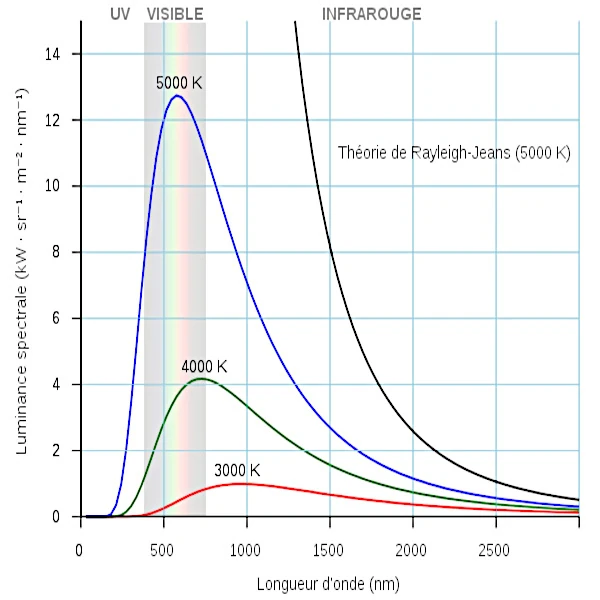
Image: Curve of the electromagnetic spectrum of a black body at different temperatures.
As can be seen in the image, the curve of the electromagnetic spectrum of a black body has a maximum intensity which shifts towards short wavelengths as the temperature of the black body increases. For example, the black body at 5000 K has a maximum intensity in the yellow region, while the black body at 4000 K has a maximum intensity in the red region and a black body at 3000 K has a maximum intensity in the infrared region. Image credit: Wikipédia (Public domain).
In physics, a black body is an ideal object which perfectly absorbs all the electromagnetic energy it receives, without reflecting or transmitting any. This complete absorption of light results in thermal agitation (random movements of molecules or atoms) which causes the emission of electromagnetic radiation, known as black body radiation.
These movements are caused by the temperature of the black body. The higher the temperature, the faster the movements and the greater the thermal agitation.
Such an object does not exist in reality, but the concept of a black body is used as an important theoretical model in thermodynamics and quantum physics.
Planck's law describes the distribution of electromagnetic energy (or the distribution of photon density) radiated by a black body at a given temperature, as a function of wavelength.
Planck's equation is as follows:
I(ν,T) = 8 π hν^3 / c^2 / (e^(hν / kBT) - 1) where:
I(ν,T) is the radiation intensity per unit area, solid angle and frequency
ν is the frequency of the radiation
T is the black body temperature
h is Planck's constant
k is Boltzmann's constant
it's the speed of light
Planck's equation predicts that the curve of a black body's electromagnetic spectrum is a bell-shaped curve, with maximum intensity at a specific wavelength. The wavelength of the maximum intensity, λmax, is given by Wien's law: λmax = hc / kBT
Planck's law was a major discovery in physics because it provided a quantitative explanation for the experimental observation that the electromagnetic spectrum of a black body is a bell-shaped curve. This law also had a profound impact on the development of quantum mechanics, notably with the work of Max Planck (1858-1947), who introduced the notion of energy quanta to explain the radiation of a black body. The amount of radiation emitted by a black body depends only on its temperature and wavelength.
Planck's law is applicable to a wide variety of sources of electromagnetic radiation, including stars, nebulae, furnaces, incandescent lamps, lasers, diodes and also to semiconductors.
Planck's law is a fundamental law of physics that has many practical applications.